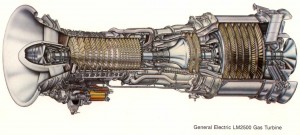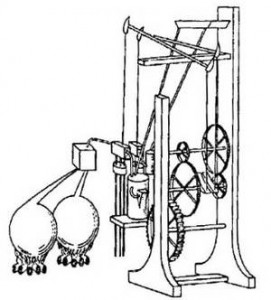A History of Gas Turbine Technology:
The makings of turbine technology has been in its development for over two millennium. A multitude of engineers, mathematicians, and physicists have aided in the culmination of this technology to the “power house” that it is today. Gas turbine technology provides for an ever increasing fraction of today’s energy needs.

- The first turbine can be seen as far back as 150 B.C., where Hero, a Greek philosopher and mathematician, invented a toy that rotated due to steam that moved through several nozzles arranged in a wheel. The ideas behind his toy would not be realized for at least another millennium.
- In 1232, Chinese invented gunpowder as a driving force, mainly used as a propellant in basic rockets.
- In 1629, Giovanni Branca developed a machine that used steam to rotate a turbine that was used to operate a stamping mill. This was the first application of turbine technology.
 In 1791, John Barber received a patent for the first basic turbine engine. Although his patent was not of tremendously useful, Barber described the principle behind gas turbines for the first time. (The image to the right is a sketch of Barber’s gas turbine)
In 1791, John Barber received a patent for the first basic turbine engine. Although his patent was not of tremendously useful, Barber described the principle behind gas turbines for the first time. (The image to the right is a sketch of Barber’s gas turbine)- Over the next century and a half, large improvements were made to the gas turbine technology such as the use of different compressors or the use of airfoils within the turbine. This led to the introduction of the gas turbine for power generation by the Brown Boveri Company of Switzerland, in 1939.
Since its inception, Gas Turbine technology as a industrial power source has come a long way. Older traditional Gas Turbine plants consisting of a single cycle process (gas turbine only) usually had an efficiency of 30-40%. These plants may be considered dated but many are still in use.
The most up-to-date technology would be the Gas Turbine Combined Cycle, which has an efficiency of up to 60% and continues to increase with further development. Adding other processes can influence turbine outputs; inter-cooling and reheating increases the maximum work output of a cycle, and regeneration can boost efficiency. With the addition of these processes and developing practices, turbine technology makes a suitable power generation technique for the foreseeable future. Advances in technology will constantly add to the possibilities of Gas Turbine technology.
Recommendations for the future:
Research on and analysis of GTCC technology has yielded the following conclusions. Please see the other sections of this section of the GTCC website for details and supporting arguments.
1. Gas turbine technology is a proven technology which has existed and has been improved upon since the late 18th Century. There exists a strong scientific and historical background for this technology’s development, and numerous plants which use this technology currently exist.
2. GTCC power plants are more efficient and economical than single -cycle coal or natural gas power plants. The higher efficiency of having two power generation cycles and the low cost of natural gas make existing and potential GTCC power plants favorable economically over a single-cycle gas or coal power plant.
3. Natural gas is a plentiful resource and is more energy dense (by volume) than coal. More than two centuries worth of natural gas is available at our current energy consumption rate, and by volume, less gas is required than coal to produce the same amount of energy.
4. Natural gas is produces a smaller amount of carbon dioxide emissions than coal. Natural gas also produces the smallest percentage of global carbon dioxide emissions out of the three traditional fossil fuels (coal, oil, and natural gas).
5. If proper procedures are observed when mining shale gas, chemicals and waste water from fracking can be safely handled, treated, and stored.
Based on these conclusions, it is recommended that GTCC technology is given incentives to be used in more places worldwide and to replace traditional coal and gas technology. It is also recommended to research and develop even more efficient ways of using natural gas to create electricity.
Resources:
Cengel, Yunis A., and Michael A. Boles. “Thermodynamics: An Engineering Approach. 7th Ed.” New York: McGraw-Hill, 2011. Print
“Early Gas Turbine History” web.mit.edu. MIT Gas Turbine Laboratory. Web. 3 May 2014
“The History of Engines – How Engines Work: Part 2: A Short History and Timeline of Gas Turbine Engines” inverters.about.com. About.com. Web. 4 May 2014
Rubin S. Edwards. Introduction to Engineering and the Environment. New York: McGraw-Hill, 2001. Print.
Primary Author: Justin Sandler
Primary Editor and Secondary Author: Eric Gallant
